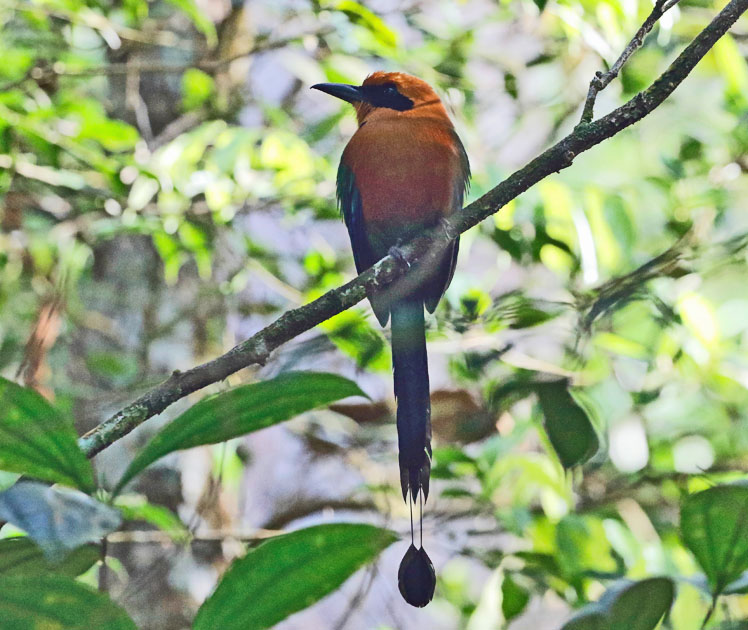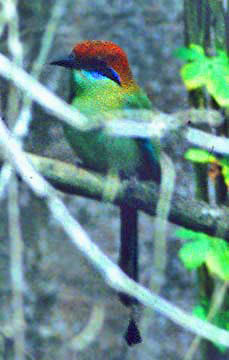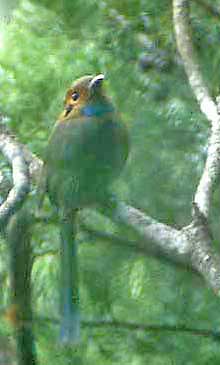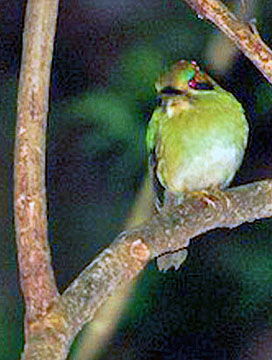
a web page by Don Roberson |
MOTMOTS Momotidae |
|||
|
|||
Broad-billed Motmot has a wide range from tropical Mexico to northern Argentina. In contrast, the only other species in its genus — Keel-billed Motmot Electron carinatum — is scarce and local from Belize to Costa Rica only. Motmots sit quietly on a shaded branches, swinging their tail side-to-side at times. It has long been said that the racquet-shaped tips of the long central tail feathers are created by the birds themselves, but the truth is more prosaic. Juvenile motmots and freshly-molted tails of adults do not have racquets but the basal feathers are attached only loosely and simply fall out through ordinary wear-and-tear. Preening can be part of that wear. Although the pendulum-like movement of the tail has long been noted, no one seems to know the precise purpose of the racquets (Snow 2001). |
|||
All of these unobtrusive forest birds form monogamous pairs that dig a long tunnel muddy, earthen banks. The female then lags eggs at the end of the tunnel. These burrows can be quite deep — up to 3-5m long (9-16 ft.) for larger species — and can take weeks to complete (Snow 2001). During these weeks of work, the bill can be quite muddy, even if the motmot comes to a feeder. This Lesson's Motmot (right), at a feeder in Costa Rica, may have been engaged in such work. Lesson's Motmot is a split from the once widespread "Blue-crowned Motmot" complex (Blue-capped M. coeruliceps, Lesson's, Whooping M. subrufescens, Trinidad M. bahamensis, Amazonian M. momota, and Andean M. aequatorialis motmots). Previously, all were classified as within a single variable species. This Trinidad Motmot (below) is one of the six new species. It, as do other "Blue-crown" congeners, was attracted to a fruit feeder at a wildlife lodge. |
|||
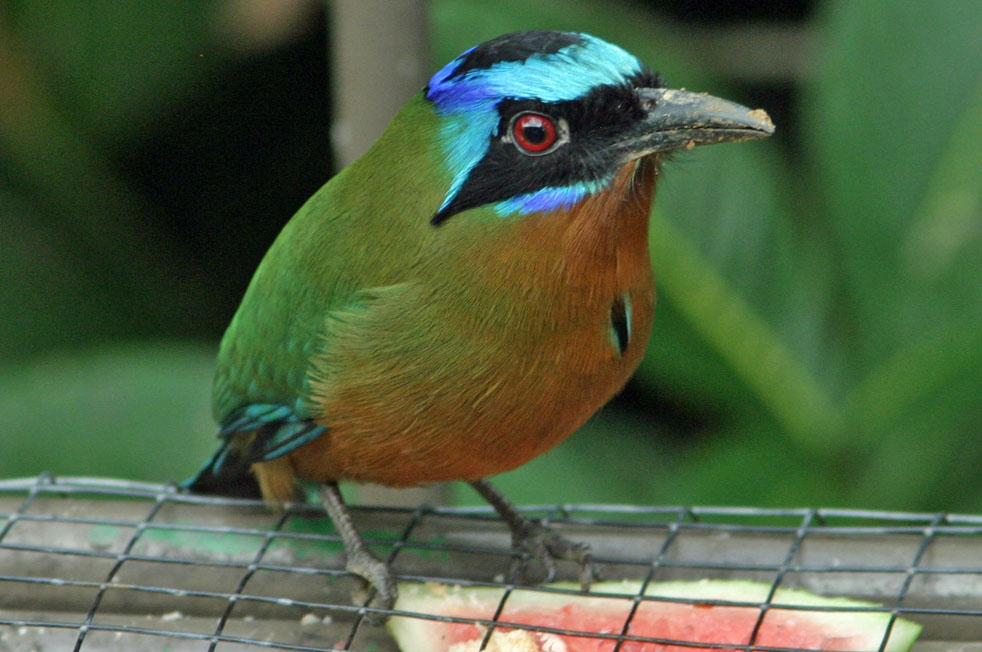 |
|||
|
|||
|
|||
Most motmots are birds of rainforests but Rufous-crowned Motmot (above left) is well-adapted to semi-arid woodlands from western Mexico to Guatemala. Within the current arrangements of genera, Rufous-crowned Motmot is now the only member of genus Momotus that never was a member of the "Blue-crowned Motmot" complex. Three motmots have 'normal' central rectrices and these species do not have racquets:
In addition, three subspecies of Broad-billed Motmot, occurring east of the Andes, lack tail racquets (sometimes considered a separate species “Plain-tailed Motmot”). All Broad-billed Motmots of all subspecies share a similar vocalization: a short, nasal groan. Motmots sally out from their perches to eat larger insects, but they also consume a variety of invertebrates, frogs, snakes, lizards, and fledgling or sick small birds. Some species also take fruit seasonally (Remsen et al. 1993). |
|||
Photos: The first two photos are of Broad-billed Motmot Electron platyrhynchum: the full-frame shot was taken in foothills above Anton Valley, Panama, on 20 Feb 2022, and the head/bill photo was from La Selva, Costa Rica, on 17 Dec 2007. The Lesson's Motmot Momotus lessonii was at Rio Tigre, Osa Peninsula, Costa Rica, on 26 Dec 2007. The Trinidad Motmot Momotus bahamensis was at Asa Wright Reserve, Trinidad, on 25 Dec 2006. The Rufous Motmot Baryphthengus martii was at Cerro Azul, Panama, on 17 Feb 2022. The Russet-crowned Motmot Momotus mexicanus was at Singayta, near San Blas, Nayarit, Mexico, on 28 Feb 1987. The Blue-throated Motmot Aspatha gularis was at El Triunfo, Chiapas, Mexico, on 23 Mar 2002. Terence Degan photographed the elusive Tody Motmot Hylomanes momotula at Cara Iguana, Anton Valley, Panama, on 20 Feb 2022.
Bibliographic note: There is no "family book" per se but a fine introduction, with some impressive photos, is in Snow (2001). Literature cited:
|
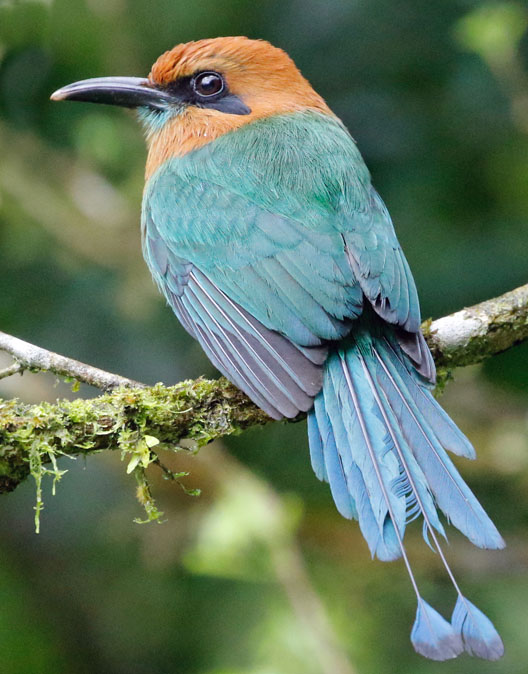 Motmots
are a small family of sit-and-wait arboreal predators in the New World
tropics. Nearly all have the same basic shape: large head, strong bill,
long body, and 9 of the 14 species have a long tail with racquets at the
end of the central rectrices. Broad-billed Motmot
(left) is a example of the "classic" motmot. Its bill,
however, is broader than most other motmots (below).
Motmots
are a small family of sit-and-wait arboreal predators in the New World
tropics. Nearly all have the same basic shape: large head, strong bill,
long body, and 9 of the 14 species have a long tail with racquets at the
end of the central rectrices. Broad-billed Motmot
(left) is a example of the "classic" motmot. Its bill,
however, is broader than most other motmots (below).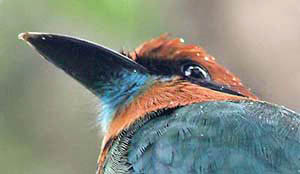
 The
name "motmot" is an original Mexican name for this group of birds, as
quoted in a 1651 travel journal, but became garbled by an early German
author to "momot," and hence the Latin name of the original genus and
family (Snow 2001).
The
name "motmot" is an original Mexican name for this group of birds, as
quoted in a 1651 travel journal, but became garbled by an early German
author to "momot," and hence the Latin name of the original genus and
family (Snow 2001). 